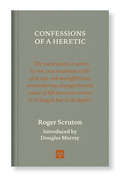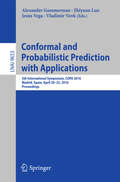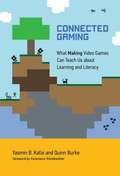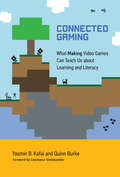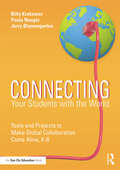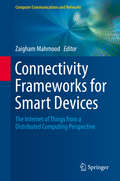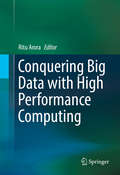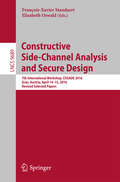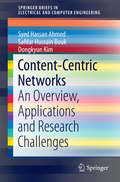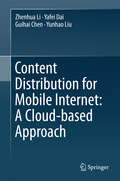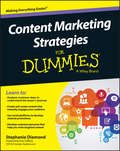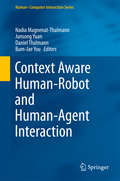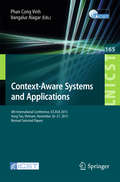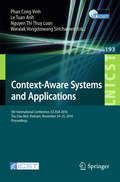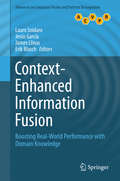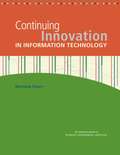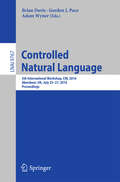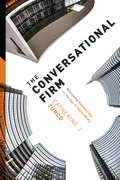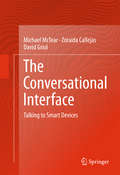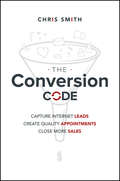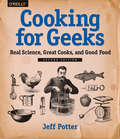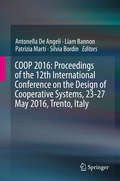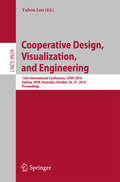- Table View
- List View
Confessions of a Heretic, Revised Edition: Selected Essays
by Roger ScrutonA revised edition of the Notting Hill Editions essay collection by the late Sir Roger Scruton with a new introduction by Douglas Murray.Confessions of a Heretic is a collection of provocative essays by the influential social commentator and polemicist Roger Scruton. Each &“confession&” reveals aspects of the author&’s thinking that his critics would probably have advised him to keep to himself. In this selection, covering subjects from art and architecture to politics and nature conservation, Scruton challenges popular opinion on key aspects of our culture: What can we do to protect Western values against Islamist extremism? How can we nurture real friendship through social media? Why is the nation-state worth preserving? How should we achieve a timely death against the advances of modern medicine? This provocative collection seeks to answer the most pressing problems of our age.In his introduction, the bestselling author and commentator Douglas Murray writes of what it cost Scruton to express views considered unpalatable, and of the importance of these ideas after Scruton&’s death.
Conformal and Probabilistic Prediction with Applications: 5th International Symposium, COPA 2016, Madrid, Spain, April 20-22, 2016, Proceedings (Lecture Notes in Computer Science #9653)
by Alexander Gammerman Zhiyuan Luo Jesús Vega Vladimir VovkThis book constitutes the refereed proceedings of the 5th InternationalSymposium on Conformal and Probabilistic Prediction with Applications, COPA2016, held in Madrid, Spain, in April 2016. The 14 revised fullpapers presented together with 1 invited paper were carefully reviewed andselected from 23 submissions and cover topics on theory of conformal prediction; applicationsof conformal prediction; and machine learning.
Connected Gaming: What Making Video Games Can Teach Us about Learning and Literacy
by Constance Steinkuehler Quinn Burke Yasmin B. KafaiOver the last decade, video games designed to teach academic content have multiplied. Students can learn about Newtonian physics from a game or prep for entry into the army. An emphasis on the instructionist approach to gaming, however, has overshadowed the constructionist approach, in which students learn by designing their own games themselves. In this book, Yasmin Kafai and Quinn Burke discuss the educational benefits of constructionist gaming -- coding, collaboration, and creativity -- and the move from "computational thinking" toward "computational participation." Kafai and Burke point to recent developments that support a shift to game making from game playing, including the game industry's acceptance, and even promotion, of "modding" and the growth of a DIY culture. Kafai and Burke show that student-designed games teach not only such technical skills as programming but also academic subjects. Making games also teaches collaboration, as students frequently work in teams to produce content and then share their games with in class or with others online. Yet Kafai and Burke don't advocate abandoning instructionist for constructionist approaches. Rather, they argue for a more comprehensive, inclusive idea of connected gaming in which both making and gaming play a part.
Connected Gaming: What Making Video Games Can Teach Us about Learning and Literacy (The John D. and Catherine T. MacArthur Foundation Series on Digital Media and Learning)
by Yasmin B. Kafai Quinn BurkeHow making and sharing video games offer educational benefits for coding, collaboration, and creativity.Over the last decade, video games designed to teach academic content have multiplied. Students can learn about Newtonian physics from a game or prep for entry into the army. An emphasis on the instructionist approach to gaming, however, has overshadowed the constructionist approach, in which students learn by designing their own games themselves. In this book, Yasmin Kafai and Quinn Burke discuss the educational benefits of constructionist gaming—coding, collaboration, and creativity—and the move from “computational thinking” toward “computational participation.” Kafai and Burke point to recent developments that support a shift to game making from game playing, including the game industry's acceptance, and even promotion, of “modding” and the growth of a DIY culture. Kafai and Burke show that student-designed games teach not only such technical skills as programming but also academic subjects. Making games also teaches collaboration, as students frequently work in teams to produce content and then share their games with in class or with others online. Yet Kafai and Burke don't advocate abandoning instructionist for constructionist approaches. Rather, they argue for a more comprehensive, inclusive idea of connected gaming in which both making and gaming play a part.
Connecting Your Students with the World: Tools and Projects to Make Global Collaboration Come Alive, K-8
by Billy Krakower Paula Naugle Jerry BlumengartenMake the most of today’s technology to give your students a more interactive, authentic learning experience! Connecting Your Students with the World shows you how to use web tools to get K–8 students in touch with other classrooms worldwide. This book is a valuable resource to help you find and communicate with other teachers and classrooms and even design your own collaborative online projects. You’ll find out how to: Conduct videoconferencing calls to put your students in touch with classrooms around the world; Embark on Virtual Field Trips; Plan themed projects for every season, including fun holiday activities; And more! The book includes detailed instructions for each activity and connections to the Common Core, ISTE, and Next Generation Science Standards, so you can ensure that you are meeting your state’s requirements as you prepare your students to become engaged, informed, and global citizens. Additionally, a comprehensive list of online resources is available as a free download from the Routledge website at www.routledge.com/9781138902961.
Connectivity Frameworks for Smart Devices: The Internet of Things from a Distributed Computing Perspective (Computer Communications and Networks)
by Zaigham MahmoodThis timely volume provides a review of the state-of-the-art frameworks and methodologies for connecting diverse objects and devices according to the vision for an Internet of Things (IoT). A specific focus is placed on the communication, security, and privacy aspects of device connectivity in distributed environments. Insights and case studies are provided by an authoritative selection of contributors of international repute into the latest research advances and practical approaches with respect to the connectivity of heterogeneous smart and sensory devices. Topics and features: Examines aspects of device connectivity within the IoT Presents a resource-based architecture for IoT, and proposes a resource management framework for corporate device clouds Reviews integration approaches for the IoT environment, and discusses performance optimization of intelligent home networks Introduces a novel solution for interoperable data management in multi-clouds, and suggests an approach that addresses the debate over network neutrality in the IoT Describes issues of data security, privacy, access control, and authentication in the distributed IoT environment Reviews the evolution of VANETs in relation to the Internet of Vehicles, and provides a perspective on developing smart sustainable cities This invaluable text/reference will be of great benefit to a broad audience, from students and researchers interested in the IoT vision, to practicing communication engineers and network security specialists.
Conquering Big Data with High Performance Computing
by Ritu AroraThis book provides an overview of the resources and research projects that are bringing Big Data and High Performance Computing (HPC) on converging tracks. It demystifies Big Data and HPC for the reader by covering the primary resources, middleware, applications, and tools that enable the usage of HPC platforms for Big Data management and processing. Through interesting use-cases from traditional and non-traditional HPC domains, the book highlights the most critical challenges related to Big Data processing and management, and shows ways to mitigate them using HPC resources. Unlike most books on Big Data, it covers a variety of alternatives to Hadoop, and explains the differences between HPC platforms and Hadoop. Written by professionals and researchers in a range of departments and fields, this book is designed for anyone studying Big Data and its future directions. Those studying HPC will also find the content valuable.
Construction Robots: Elementary Technologies and Single-Task Construction Robots ( Cambridge handbooks in construction robotics vol. #3)
by Thomas Bock Thomas LinnerLearn how Single-Task Construction Robots (STCRs) can improve productivity in the construction industry with this cross-disciplinary text. This third volume in the Cambridge Handbooks in Construction Robotics series discusses the STCRs employed on construction sites since the development of the approach in the 1980s, presents current applications, and highlights upcoming trends in the construction automation and robotics field. Two hundred different types of STCR are presented, from the simplest models comprising simple manipulators and mobile platforms, to those utilizing more sophisticated technologies such as aerial robotics, swarm robotics, exoskeletons, additive manufacturing technologies, self-assembling building structures, and humanoid robotics. Real-world case studies demonstrate the different application scenarios for each approach, and highlight the key implementation and management issues. With an easy-to-follow structure, and including hundreds of color illustrations, it provides an excellent toolkit for professional engineers, researchers, and students. Provides a new interpretation of architecture and construction as a manufacturing industry that deals with product rather than with buildings - from building 'construction' to building 'production' Follows a cross-disciplinary approach that relates traditional architectural and construction knowledge the with latest knowledge from manufacturing, automation and robot technology Oriented towards technology application, using real-world case studies to show application scenarios for each presented approach or technology
Constructive Side-Channel Analysis and Secure Design: 7th International Workshop, COSADE 2016, Graz, Austria, April 14-15, 2016, Revised Selected Papers (Lecture Notes in Computer Science #9689)
by François-Xavier Standaert Elisabeth OswaldThis book constitutes revised selected papers from the 7th International Workshop on Constructive Side-Channel Analysis and Secure Design, COSADE 2016, held in Graz, Austria, in April 2016. The 12 papers presented in this volume were carefully reviewed and selected from 32 submissions. They were organized in topical sections named: security and physical attacks; side-channel analysis (case studies); fault analysis; and side-channel analysis (tools).
Consumer Attitudes Toward Data Breach Notifications and Loss of Personal Information
by Diana Catherine Lavery Paul Heaton Sasha Romanosky Lillian AblonAlthough spending on cybersecurity continues to grow, companies, government agencies, and nonprofit organizations are still being breached, and sensitive personal, financial, and health information is still being compromised. This report sets out the results of a study of consumer attitudes toward data breaches, notifications that a breach has occurred, and company responses to such events.
Content-Centric Networks: An Overview, Applications and Research Challenges (SpringerBriefs in Electrical and Computer Engineering #0)
by Syed Hassan Ahmed Safdar Hussain Bouk Dongkyun KimThis book introduces Content-Centric Networking (CCN), a networking paradigm that provides a simple and effective solution to the challenging demands of future wired and wireless communications. It provides an overview of the recent developments in the area of future internet technologies, bringing together the advancements that have been made in Information-Centric Networking (ICN) in general, with a focus on CCN. It begins with an introduction to the basics of CCN is followed by an overview of the current internet paradigm and its challenges. Next, an application perspective has been included, where the authors encompass the selected applications for CCN with recent refereed research and developments. These applications include Internet of Things (IoT), Smart Grid, Vehicular Ad hoc Networks (VANETs), and Wireless Sensor Networks (WSNs). The book is a useful reference source for practising researchers, and can be used as supporting material for undergraduate and graduate level courses in computer science and electrical engineering.
Content Distribution for Mobile Internet: A Cloud-based Approach
by Yunhao Liu Zhenhua Li Yafei Dai Guihai ChenThis book investigates the cloud-based techniques of content distribution mainly for mobile Internet. It starts with hot topics such as cellular traffic optimization and video content delivery. By integrating the cloud scheme, it further tackles issues of traffic-saving, energy-efficient, high-speed, and delay-tolerant content delivery with regard to mobile Internet. It covers both theoretical algorithms and their real-world system implementations. In particular, various well-known cloud platforms such as Baidu Traffic Guard, Tencent QQXuanfeng, Google Drive, Microsoft OneDrive, and Dropbox are elaborated respectively in the book. Lastly, it includes an educational and experimental cloud computing platform allowing public access, which benefits researchers, practitioners, and developers in the field of cloud computing/storage and mobile Internet. Throughout the book there are helpful and practical tips on setting up cloud systems that readers can easily follow.
Content Marketing Strategies For Dummies
by Stephanie DiamondDrive your content marketing campaign toward success Blogs and social platforms are all the rage right now-especially for strategists looking to cultivate influence among target audience members through content marketing. Content Marketing Strategies For Dummies explains how you can use content marketing to gain an edge over your competition, even in the most crowded of marketplaces. This timely text introduces you to the Five C Cycle: Company Focus, Customer Experience, Content Creation, Channel Promotion, and Closed-Loop Analysis. The Five C Cycle drives the creation and documentation of a targeted content marketing strategy, and allows you to approach your content marketing campaign with confidence. By helping you determine your company's focus, uncover your customers' experience with data, develop channel promotions across social platforms, create actionable online content, and use closed-loop analysis to build on previous success, this will become your go-to content marketing guide. Content marketing entails creating and curating content online via blog posts, social media platforms, and more. The goal is to acquire and retain customers by creating content that brings value to their lives, and that encourages them to engage with your brand. This easy-to-understand guide will help you do just that. Analyze customer data to better understand your target audience's journey Leverage social platforms, such as Facebook and Twitter, to develop channel promotions Create and curate intelligent, engaging content that leads to action Build upon your previous success with closed-loop analysis Whether you work for a large corporation, are part of a small business, are a solo thought leader, or are an educator, Content Marketing Strategies For Dummies tells you how to gain a critical, competitive advantage through targeted content marketing strategies.
Context Aware Human-Robot and Human-Agent Interaction (Human–Computer Interaction Series)
by Daniel Thalmann Nadia Magnenat-Thalmann Junsong Yuan Bum-Jae YouThis is the first book to describe how Autonomous Virtual Humans and Social Robots can interact with real people, be aware of the environment around them, and react to various situations. Researchers from around the world present the main techniques for tracking and analysing humans and their behaviour and contemplate the potential for these virtual humans and robots to replace or stand in for their human counterparts, tackling areas such as awareness and reactions to real world stimuli and using the same modalities as humans do: verbal and body gestures, facial expressions and gaze to aid seamless human- computer interaction (HCI). The research presented in this volume is split into three sections: User Understanding through Multisensory Perception: deals with the analysis and recognition of a given situation or stimuli, addressing issues of facial recognition, body gestures and sound localization. Facial and Body Modelling Animation: presents the methods used in modelling and animating faces and bodies to generate realistic motion. Modelling Human Behaviours: presents the behavioural aspects of virtual humans and social robots when interacting and reacting to real humans and each other. Context Aware Human-Robot and Human-Agent Interaction would be of great use to students, academics and industry specialists in areas like Robotics, HCI, and Computer Graphics.
Context-Aware Systems and Applications: 4th International Conference, ICCASA 2015, Vung Tau, Vietnam, November 26-27, 2015, Revised Selected Papers (Lecture Notes of the Institute for Computer Sciences, Social Informatics and Telecommunications Engineering #165)
by Phan Cong Vinh Vangalur AlagarThis book constitutesthe thoroughly refereed proceedings of the 4th International Conference onContext-Aware Systems and Applications, ICCASA 2015, held in Vung Tau, Vietnam,in November 2015. The 44 revised full papers presented were carefully selectedand reviewed from over 100 submissions. The papers cover a wide spectrum ofissues in the area of context-aware systems (CAS) and context-basedrecommendation systems. CAS is characterized by its self- facets such as self-organization, self-configuration,self-healing, self-optimization, self-protection and so on whose context awarenessused to dynamically control computing and networking functions. The overallgoal of CAS is to realize nature-inspired autonomic systems that can manage themselveswithout direct human interventions.
Context-Aware Systems and Applications: 5th International Conference, ICCASA 2016, Thu Dau Mot, Vietnam, November 24-25, 2016, Proceedings (Lecture Notes of the Institute for Computer Sciences, Social Informatics and Telecommunications Engineering #193)
by Phan Cong Vinh Le Tuan Anh Nguyen Thi Thuy Loan Waralak Vongdoiwang SiricharoenThis book constitutesthe thoroughly refereed proceedings of the 4th International Conference onContext-Aware Systems and Applications, ICCASA 2015, held in Vung Tau, Vietnam,in November 2015. The 44 revised full papers presented were carefully selectedand reviewed from over 100 submissions. The papers cover a wide spectrum ofissues in the area of context-aware systems (CAS) and context-basedrecommendation systems. CAS is characterized by its self- facets such as self-organization, self-configuration,self-healing, self-optimization, self-protection and so on whose context awarenessused to dynamically control computing and networking functions. The overallgoal of CAS is to realize nature-inspired autonomic systems that can manage themselveswithout direct human interventions.
Context-Enhanced Information Fusion: Boosting Real-World Performance with Domain Knowledge (Advances in Computer Vision and Pattern Recognition #0)
by Jesús García Lauro Snidaro James Llinas Erik BlaschThis text reviews the fundamental theory and latest methods for including contextual information in fusion process design and implementation. Chapters are contributed by the foremost international experts, spanning numerous developments and applications. The book highlights high- and low-level information fusion problems, performance evaluation under highly demanding conditions, and design principles. A particular focus is placed on approaches that integrate research from different communities, emphasizing the benefit of combining different techniques to overcome the limitations of a single perspective. Features: introduces the terminology and core elements in information fusion and context; presents key themes for context-enhanced information fusion; discusses design issues in developing context-aware fusion systems; provides mathematical grounds for modeling the contextual influences in representative fusion problems; describes the fusion of hard and soft data; reviews a diverse range of applications.
Continuing Innovation in Information Technology: Workshop Report
by Engineering Medicine National Academies of SciencesThe 2012 National Research Council report Continuing Innovation in Information Technology illustrates how fundamental research in information technology (IT), conducted at industry and universities, has led to the introduction of entirely new product categories that ultimately became billion-dollar industries. The central graphic from that report portrays and connects areas of major investment in basic research, university-based research, and industry research and development; the introduction of important commercial products resulting from this research; billion-dollar-plus industries stemming from it; and present-day IT market segments and representative U.S. firms whose creation was stimulated by the decades-long research. At a workshop hosted by the Computer Science and Telecommunications Board on March 5, 2015, leading academic and industry researchers and industrial technologists described key research and development results and their contributions and connections to new IT products and industries, and illustrated these developments as overlays to the 2012 "tire tracks" graphic. The principal goal of the workshop was to collect and make available to policy makers and members of the IT community first-person narratives that illustrate the link between government investments in academic and industry research to the ultimate creation of new IT industries. This report provides summaries of the workshop presentations organized into five broad themes - (1) fueling the innovation pipeline, (2) building a connected world, (3) advancing the hardware foundation, (4) developing smart machines, and (5) people and computers - and ends with a summary of remarks from the concluding panel discussion.
Controlled Natural Language: 5th International Workshop, CNL 2016, Aberdeen, UK, July 25-27, 2016, Proceedings (Lecture Notes in Computer Science #9767)
by Brian Davis Gordon J. Pace Adam WynerThis book constitutes the refereed proceedings of the 5th International Workshop on Controlled Natural Language, CNL 2016, held in Aberdeen, UK, in July 2016. The 11 full papers presented were carefully reviewed and selected from 15 submissions. The topics range from natural languages which are controlled, to controlled languages with a natural language flavour; and from more theoretical results to interfaces, reasoning engines and real-life applications of CNLs.
The Conversational Firm: Rethinking Bureaucracy in the Age of Social Media (The Middle Range Series)
by Catherine TurcoA fast-growing social media marketing company, TechCo encourages all of its employees to speak up. By promoting open dialogue across the corporate hierarchy, the firm has fostered a uniquely engaged workforce and an enviable capacity for change. Yet the path hasn't always been easy. TechCo has confronted a number of challenges, and its experience reveals the essential elements of bureaucracy that remain even when a firm sets out to discard them. Through it all, TechCo serves as a powerful new model for how firms can navigate today's rapidly changing technological and cultural climate.Catherine J. Turco was embedded within TechCo for ten months. The Conversational Firm is her ethnographic analysis of what worked at the company and what didn't. She offers multiple lessons for anyone curious about the effect of social media on the corporate environment and adds depth to debates over the new generation of employees reared on social media: Millennials who carry their technological habits and expectations into the workplace. Marshaling insights from cultural and economic sociology, organizational theory, economics, technology studies, and anthropology, The Conversational Firm offers a nuanced analysis of corporate communication, control, and culture in the social media age.
The Conversational Interface
by Michael Mctear Zoraida Callejas David GriolThis book provides a comprehensive introduction to the conversational interface, which is becoming the main mode of interaction with virtual personal assistants, smart devices, various types of wearable, and social robots. The book consists of four parts. Part I presents the background to conversational interfaces, examining past and present work on spoken language interaction with computers. Part II covers the various technologies that are required to build a conversational interface along with practical chapters and exercises using open source tools. Part III looks at interactions with smart devices, wearables, and robots, and discusses the role of emotion and personality in the conversational interface. Part IV examines methods for evaluating conversational interfaces and discusses future directions.
The Conversion Code: Capture Internet Leads, Create Quality Appointments, Close More Sales
by Chris Smith"If you need more traffic, leads and sales, you need The Conversion Code."Neil Patel co-founder Crazy Egg"We've helped 11,000+ businesses generate more than 31 million leads and consider The Conversion Code a must read."Oli Gardner co-founder Unbounce"We'd been closing 55% of our qualified appointments. We increased that to 76% as a direct result of implementing The Conversion Code."Dan Stewart CEO Happy Grasshopper"The strategies in The Conversion Code are highly effective and immediately helped our entire sales team. The book explains the science behind selling in a way that is simple to remember and easy to implement." Steve Pacinelli CMO BombBombCapture and close more Internet leads with a new sales script and powerful marketing templatesThe Conversion Code provides a step-by-step blueprint for increasing sales in the modern, Internet-driven era. Today's consumers are savvy, and they have more options than ever before. Capturing their attention and turning it into revenue requires a whole new approach to marketing and sales. This book provides clear guidance toward conquering the new paradigm shift towards online lead generation and inside sales. You'll learn how to capture those invaluable Internet leads, convert them into appointments, and close more deals. Regardless of product or industry, this proven process will increase both the quantity and quality of leads and put your sales figures on the rise.Traditional sales and marketing advice is becoming less and less relevant as today's consumers are spending much more time online, and salespeople are calling, emailing, and texting leads instead of meeting them in person. This book shows you where to find them, how to engage them, and how to position your company as the ideal solution to their needs. Engage with consumers more effectively online Leverage the strengths of social media, apps, and blogs to capture more leads for less money Convert more Internet leads into real-world prospects and sales appointments Make connections on every call and learn the exact words that close more sales The business world is moving away from "belly-to-belly" interactions and traditional advertising. Companies are forced to engage with prospective customers first online—the vast majority through social media, mobile apps, blogs, and live chat—before ever meeting in person. Yesterday's marketing advice no longer applies to today's tech savvy, mobile-first, social media-addicted consumer, and the new sales environment demands that you meet consumers where they are and close them, quickly. The Conversion Code gives you an actionable blueprint for capturing Internet leads and turning them into customers.
Cooking for Geeks: Real Science, Great Cooks, and Good Food (2nd Edition)
by Jeff PotterWhy do we cook the way we do? Are you the innovative type, used to expressing your creativity instead of just following recipes? Do you want to learn to be a better cook or curious about the science behind what happens to food as it cooks?More than just a cookbook, Cooking for Geeks applies your curiosity to discovery, inspiration, and invention in the kitchen. Why do we bake some things at 350°F/175°C and others at 375°F/190°C? Why is medium-rare steak so popular? And just how quickly does a pizza cook if we overclock an oven to 1,000 F/540 C? Author and cooking geek Jeff Potter provides the answers to these questions and more, and offers his unique take on recipes -- from the sweet (a patent-violating chocolate chip cookie) to the savory (slow-cooked brisket).This book is an excellent and intriguing resource for anyone who enjoys cooking or wants to experiment in the kitchen.Discover what type of cook you are and calibrate your tools Learn about the important reactions in cooking, such as protein denaturation, Maillard reactions, and caramelization, and how they impact the foods we cook. Gain firsthand insights from interviews with researchers, food scientists, knife experts, chefs, writers, and more, including author Harold McGee, TV personality Adam Savage, and chemist Hervé.
COOP 2016: Proceedings of the 12th International Conference on the Design of Cooperative Systems, 23-27 May 2016, Trento, Italy
by Antonella De Angeli Liam Bannon Patrizia Marti Silvia BordinThis volume presents the proceedings of the 12th International Conference on the Design of Cooperative Systems (COOP 2016). The conference is a venue for multidisciplinary research contributing to the design, assessment and analysis of cooperative systems and their integration in organizations, public venues, and everyday life. COOP emerged from the European tradition of Computer Supported Cooperative Work (CSCW) and Cognitive Ergonomics. A collection of 22 papers and 4 workshop overviews are presented, reflecting the variety of research activities in the field of the design of cooperative systems with a special emphasis on "Making Together" This collection offers a broad vision of collective working practices and cooperative design, embracing the idea that design requires a deep understanding of collective activities, involving both artefacts and social practices within a context. The result is a rich and articulated debate that widens the design space towards the exploration of a variety of forms of participation and engagement in collaborative system design. Experienced researchers, academics, designers and practitioners who are interested in collaborative design theory and methods would be interested in the state of the art research and case studies this collection provides.
Cooperative Design, Visualization, and Engineering: 13th International Conference, CDVE 2016, Sydney, NSW, Australia, October 24–27, 2016, Proceedings (Lecture Notes in Computer Science #9929)
by Yuhua LuoThis book constitutes the refereed proceedings of the 13th International Conference on Cooperative Design, Visualization, and Engineering, CDVE 2016, held in Sydney, NSW, Australia, in October 2016. The 9 full papers and 42 short papers presented were carefully reviewed and selected from 89 submissions. The papers cover a broad range of topics in the field of cooperative visualization, visual analytics, cooperative engineering, and cooperative design and applications.
